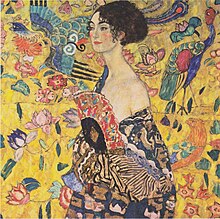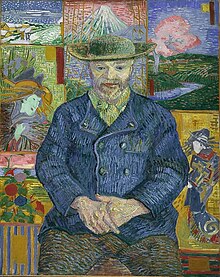Japonism


Japonism (also in French Japonisme or Japonaiserie, ジ ャ ポ ニ ス ム ) is the name for the influence of Japanese art on the artists of the western world , especially French. The art that emerged from this source of inspiration is known as Japonesque .
The imagery and design language of the "images of the cheerful, transitory world", the ukiyo-e , and other products of Japanese handicrafts such as pottery, metal, lacquer and bamboo work became a source of inspiration for Impressionism , Art Nouveau , the Art Nouveau , the Vienna Secession and many artists of Expressionism .
history
As a result of internal pressure from the reformers and external pressure from the colonial powers, above all the Americans under Matthew Perry , Japan ended its long-term isolation in the 1850s . Just as western painting, printing and photography techniques came to Japan, Japanese woodblock prints took the opposite route to Europe, first as packaging material for tea and other goods. In Europe, however, the high artistic value of these prints was recognized, and a veritable collecting craze of Japanese art arose.
The term "Japonism" was coined in 1872 by the French art critic Philippe Burty . French collectors, aesthetes and art critics made trips to Japan in the 1870s and 1880s, sparking a series of essays on Japanese art and an increased trade in it. Among them are the economist Henri Cernuschi and the critic Théodore Duret (both 1871–1872), and the British collector William Anderson , who taught medicine in Edo for a few years. Anderson's collection was later acquired by the British Museum . Several dealers in Japanese art established themselves in Paris, including Tadamasa Hayashi and Jijima Hanjuro . Probably the most important contribution was made by Siegfried Bing (Samuel Bing) from Hamburg . The Paris World's Fair in 1878 showed a number of works of Japanese art.
Artists and styles
Japanese artists who made a huge impact were Utamaro , Hokusai, and Hiroshige . But while interest in Japanese prints was booming in Europe, cultural renewal ( 文明 開化 , bummei kaika ) in Japan led to increased interest in Western art and a loss of prestige for traditional Japanese artists and techniques.
Japonism in France
The artists who were influenced by Japanese art in France included e.g. B. Édouard Manet , Claude Monet , Camille Pissarro , Edgar Degas , Paul Gauguin and Vincent van Gogh . Manet's enthusiasm for Japanese art is particularly evident in his portrait of the writer Émile Zola . Many of Van Gogh's paintings imitate ukiyo-e in style and motif. Le Père Tanguy, for example, which portrays the owner of an art supplies shop, shows six different woodcuts in the background. Van Gogh painted The Courtesan in 1887, based on a ukiyo-e by Kesai Eisen, on the cover of Paris Illustré, Le Japon . At that time, in Antwerp , he was already collecting Japanese stamps .
Ukiyo-e with its curved lines and contrasting empty spaces, its schematic structure and the two-dimensionality of its image plane, also inspired Art Nouveau . Some line shapes and curve patterns became graphic set pieces that were later found in the works of artists all over the world.
The stylistic devices of the Japanese color woodcut were particularly appreciated and disseminated by the painters of the Pont-Aven school and the Nabis . Interestingly, the latter understood Japanese woodblock prints as folk art .
Japonism in Germany
The German-speaking artist Emil Orlik , who comes from Prague and works in Vienna and Berlin, traveled to Japan in 1900/01. From there he brought drawings with him, which he implemented in his own woodcuts and etchings - technically and in terms of motifs, following the Japanese woodblock prints. Stylistically, however, his oeuvre remained unaffected by Japanese art.
The first major exhibition of works of art from the Far East took place in Munich in 1909 under the title “Japan and East Asia in Art”.
In Germany it was two Russians, Marianne von Werefkin and Alexej Jawlensky , who collected Japanese art at the beginning of the 20th century and who dealt intensively with Far Eastern art. Japanese woodcuts, which they transformed, shaped their painting style and enriched expressionist painting .
Equivalent to other works of art, Werefkin and Jawlensky used Japanese woodcuts as wall decorations. It is assumed that their friend Gustav Pauli , one of the leading German Japan experts at the time, helped them build up their Japan collection. The collection consisted mainly of works by Kunisada , but there were also some works by Hokusai , Utamaro and Kuniyoshi .

Werefkins and Jawlensky's colleagues Franz Marc and August Macke were also admirers of Japanese art. They also collected handicrafts, ukiyo-e and shunga leaves , just like Jawlensky. In the exhibition The Painters of the “Blue Rider” and Japan , which ran from July 21 to November 6, 2011, the Murnau Castle Museum referred for the first time to the influence of Japanese art on the artists of the Blue Rider . Collection items by the painters, including the Japanese art collection of Franz Marc and examples of works by the artists, formed the spectrum of the exhibition.
In the Almanach Der Blaue Reiter , published by Wassily Kandinsky and Marc in mid-May 1912 and provided with 144 illustrations, Japanese illustrations play a rather subordinate role compared to non-European ethnological or Bavarian and Russian folklore examples.
In 2013, an exhibition at the Zentrum Paul Klee in Bern first referred to Paul Klee's preoccupation with East Asian art. It ran until May 12th under the title From Japonism to Zen. Paul Klee and the Far East .
The graphic artist, set designer and writer Emil Preetorius , who worked in Munich in the broader Art Nouveau context , published a study in 1937 entitled On the essence of East Asian painting .
Japonism in England
The American James McNeill Whistler is one of the first collectors and recipients of Western European art history, so to speak, one of the very first 'Japonists' ”. Raised up in Russia, he received drawing lessons at the Imperial Art Academy in St. Petersburg when he was 11 . After the death of his father, the family returned to America in 1849. When he continued his artistic training in Paris in 1855, he got to know Asian art. He was so fascinated by foreign art objects that he acquired a collection that he brought to England when he moved to London in 1859, where he was the only one to make a significant contribution to the spread of Japanese fashion.
In his house, which he decorated with Japanese and Chinese wall screens, fans and porcelain, he constantly had Asian objects in mind, which he processed in his paintings and etchings.
Aubrey Beardsley was one of the artists who dealt intensively with Japanese woodblock prints . The Japanese influence in his work is unmistakable.
literature
- Ursula Perucchi-Petri, Die Nabis and Japan , Munich 1976
- Klaus Berger, Japonism in Western Painting 1860-1920 , Munich 1980
- Bernd Fäthke, Jawlensky, van Gogh and Japan , in exh. Cat .: Alexej Jawlensky, drawing-graphic documents, Museum Wiesbaden 1983, p. 32 ff.
- Exhib. Cat .: Le Japonisme , Galeries nationales du Grand Palais, Paris 1988
- Gerhard Dambmann, How Japan Discovered the West, A Story in Color Woodcuts, Stuttgart / Zurich 1988
- Exhib. Cat .: Japan and Europe 1543-1929 , (43rd Berlin Festival Weeks ), Martin-Gropius-Bau, Berlin 1993
- Exhib. Cat .: Japan Source of Inspiration , International Days, Japanese Art and European Modernism around 1900, Ingelheim 2001
- Exhib. Cat .: Impressionism and Japanese fashion - Edgar Degas, James McNeill Whistler , Städtische Galerie Überlingen, Michael Imhof Verlag, Petersberg 2009, ISBN 978-3-86568-363-2 .
- Exhib. Cat .: Cézanne, Degas, Matisse - Hokusai, Hiroshige, Utamaro. Artists of the French avant-garde and Japanese woodblock prints from the Scharf-Gerstenberg Collection , Kunsthaus Kaufbeuren, Kaufbeuren 2009.
- Julia Meech, Gabriel P. Weisberg, Japonisme Comes to America: The Japanese Impact on the Grafic Arts, 1876-1925 . New York 1990, ISBN 0-8109-3501-5 .
- Brigitte Salmen (Ed.): "... these tender, spirited fantasies ...". The painters of the “Blue Rider” and Japan. Murnau Castle Museum 2011, ISBN 978-3-932276-39-2 .
- Siegfried Wichmann : Japonism: East Asia - Europe. Encounters in the art of the 19th and 20th centuries . Herrsching 1980, ISBN 3-7796-5177-7 .
- Michiko Mae; Elisabeth Scherer (ed.): Nipponspiration - Japonism and Japanese popular culture in German-speaking countries. Böhlau, Vienna, Cologne, Weimar 2013, ISBN 978-3-412-21019-9 .
Individual evidence
- ^ Philippe Burty: University of Glasgow , etchings.arts.gla.ac.uk, accessed on February 2, 2013
- ↑ Tsukasa Kodera, Van Gogh's Utopian Japonisme, in: Catalog of the Van Gogh-Museurn's collection of Japanese prints, Van Gogh Museum, Amsterdam 1991, p. 12 ff.
- ↑ Bogomila Welsh-Ovcharow, Vincent van Gogh and the Birth of Cloisonism, exh. Cat .: Art Gallery of Ontario, Toronto 1981, p. 114 f.
- ↑ Exhib. Cat .: Le Chemin de Gauguin, genèse et rayonnement, Musée Départemental du Prieuré, Saint-Germain-en-Laye 1985, pp. 32-112.
- ↑ Ursula Perucchi-Petri, Die Nabis and Japan, Munich 1976
- ↑ Ursula Perucchi-Petri, The Nabis and Japonism, in exh. Cat .: Die Nabis, Prophets of Modernism, Kunsthaus Zürich, Zürich 1993, p. 33.
- ^ Cäcilie and Oscar Graf, Japan and East Asia in Art, Official Catalog of the Exhibition, Munich 1909, p. 104.
- ↑ Bernd Fäthke, Marianne Werefkin, Munich 2001, p. 133 ff.
- ↑ Bernd Fäthke, Jawlensky and his companions in a new light, Munich 2004, pp. 127–138.
- ↑ Pauli had systematically built up the color woodcut department of the Bremen Kunsthalle and also organized four exhibitions between 1902 and 1908 with woodcuts and handicrafts that came from the Far Eastern island kingdom. Vg .: Siegfried Salzmann, Gustav Pauli's purchasing policy and Japonism, in: Scenes from ancient Japan. Japanese woodblock prints from our own possession, exh. Cat .: Kunsthalle Bremen 1990, p. 238 f.
- ^ German art archive, Germanisches Nationalmuseum Nürnberg, estate of Franz Marc
- ↑ August Macke, Letters to Elisabeth and Friends, ed. by Werner Frese and Ernst-Gerhard Güse, Munich 1987, p. 118.
- ↑ August Macke / Franz Marc, Briefwechsel, ed. by Wolfgang Macke, Cologne 1964, pp. 27, 34, 36.
- ↑ Bernd Fäthke, Jawlensky and his companions in a new light, Munich 2004, p. 129.
- ^ The painters of the "Blauer Reiter" and Japan , www.schlossmuseum-murnau.de, accessed on August 18, 2011
- ^ Klaus Lankheit: Der Blaue Reiter, edited by Wassily Kandinsky and Franz Marc, new documentary edition, Munich / Zurich 1984
- ↑ Annette Splieth-Locherer, East Asian Art, in exh. Cat .: The almanac “Der Blaue Reiter”, pictures and images in originals, Schloßmuseum des Marktes Murnau 1998, p. 153 ff.
- ↑ From Japonism to Zen. Paul Klee and the Far East , zpk.org, accessed February 14, 2013.
- ↑ Claudia Däubler-Hauschke, Impressionism and Japanese Fashion, in exh. Cat .: Impressionism and Japanese fashion, Edgar Degas / James McNeill Whistler, Städtische Galerie Überlingen 2009, Petersberg 2009, p. 9.
- ↑ Klaus Berger, Japonism in Western Painting 1860–1920, Munich 1980, p. 36.
- ↑ Hendrik Budde, Japanese Color Woodcuts and European Art: Painters and Collectors in the 19th Century, in exh. Cat .: Japan and Europe 1543–1929, “43. Berliner Festwochen "in the Martin-Gropius-Bau, Berlin 1993, p. 168.
Web links
- thesis: Edo print art and its Western interpretations (pdf, English; 2.57 MB)
- Perception du Japon (French)
- Japonisme (French)
- small Japonism-gallery (engl.)
- Comments on some van Gogh paintings after ukiyo-e (French)
- When the impressionists discover Japan. Documentation France 2017.


